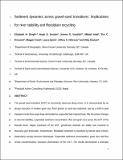Files in this item
Sediment dynamics across gravel-sand transitions : implications for river stability and floodplain recycling
Item metadata
| dc.contributor.author | Dingle, Elizabeth | |
| dc.contributor.author | Sinclair, Hugh | |
| dc.contributor.author | Venditti, Jeremy | |
| dc.contributor.author | Attal, Mikaël | |
| dc.contributor.author | Kinnaird, Tim C. | |
| dc.contributor.author | Creed, Maggie | |
| dc.contributor.author | Quick, Laura | |
| dc.contributor.author | Nittrouer, Jeffrey | |
| dc.contributor.author | Gautam, Dilip | |
| dc.date.accessioned | 2021-02-14T00:39:41Z | |
| dc.date.available | 2021-02-14T00:39:41Z | |
| dc.date.issued | 2020-05-01 | |
| dc.identifier | 267779753 | |
| dc.identifier | 3dc0594c-2be5-4368-adc5-a46fffd222be | |
| dc.identifier | 000529525600012 | |
| dc.identifier | 85084110895 | |
| dc.identifier.citation | Dingle , E , Sinclair , H , Venditti , J , Attal , M , Kinnaird , T C , Creed , M , Quick , L , Nittrouer , J & Gautam , D 2020 , ' Sediment dynamics across gravel-sand transitions : implications for river stability and floodplain recycling ' , Geology , vol. 48 , no. 5 , pp. 468-472 . https://doi.org/10.1130/G46909.1 | en |
| dc.identifier.issn | 0091-7613 | |
| dc.identifier.uri | https://hdl.handle.net/10023/21429 | |
| dc.description | Data collection was funded through a NERC GCRF Building Resilience grant (NE/P015905/1) to H.D.S. and an EPSRC GCRF Institutional grant (EP/P510944/1) to M.A. Sampling equipment was lent by Ed Tipper and Bob Hilton. The RTK-GPS was loaned from the NERC Geophysical Equipment Facility. | en |
| dc.description.abstract | The gravel-sand transition (GST) is commonly observed along rivers. It is characterized by an abrupt reduction in median grain size, from gravel- to sand-size sediment, and by a shift in sand transport mode from wash load–dominated to suspended bed material load. We documented changes in channel stability, suspended sediment concentration, flux, and grain size across the GST of the Karnali River, Nepal. Upstream of the GST, gravel-bed channels are stable over hundred- to thousand-year time scales. Downstream, floodplain sediment is reworked by lateral bank erosion, particularly during monsoon discharges. Suspended sediment concentration, grain size, and flux reveal counterintuitive increases downstream of the GST. The results demonstrate a dramatic change in channel dynamics across the GST, from relatively fixed, steep gravel-bed rivers with infrequent avulsion to lower-gradient, relatively mobile sand-bed channels. The increase in sediment concentration and near-bed suspended grain size may be caused by enhanced channel mobility, which facilitates exchange between bed and bank material. These results bring new constraints on channel stability at mountain fronts and indicate that temporally and spatially limited sediment flux measurements downstream of GSTs are more indicative of flow stage and floodplain recycling than of continental-scale sediment flux and denudation rate estimates. | |
| dc.format.extent | 1033603 | |
| dc.language.iso | eng | |
| dc.relation.ispartof | Geology | en |
| dc.subject | GE Environmental Sciences | en |
| dc.subject | NDAS | en |
| dc.subject.lcc | GE | en |
| dc.title | Sediment dynamics across gravel-sand transitions : implications for river stability and floodplain recycling | en |
| dc.type | Journal article | en |
| dc.contributor.institution | University of St Andrews. School of Earth & Environmental Sciences | en |
| dc.identifier.doi | https://doi.org/10.1130/G46909.1 | |
| dc.description.status | Peer reviewed | en |
| dc.date.embargoedUntil | 2021-02-14 |
This item appears in the following Collection(s)
Items in the St Andrews Research Repository are protected by copyright, with all rights reserved, unless otherwise indicated.

